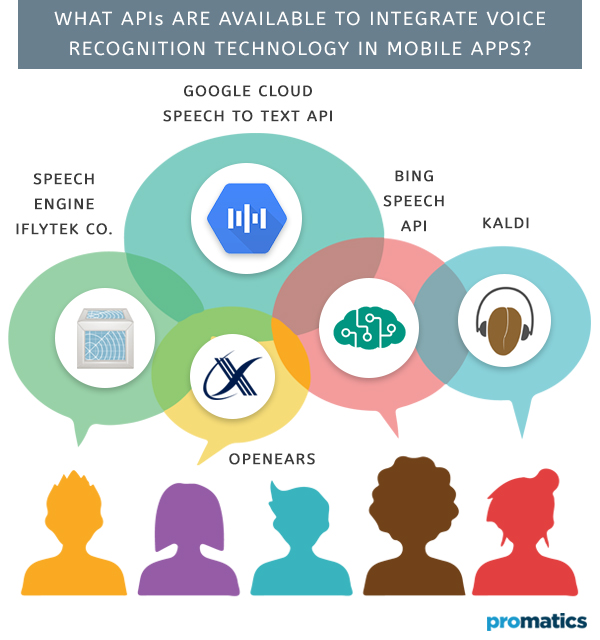Voice activated apps are already here powered by VFT or Voice First Technology: What are the challenges and solutions?
The introduction of voice assistants has provided new ways to interact with your smartphone. The availability of voice recognition software has encouraged mobile app developer to create voice-activated apps on smartphone platforms like Android and iOS. There has been increasing demand from smartphone users for better interfaces, especially which does not require the user to use touchscreens for input. There is no doubt you will see many of your regular apps getting Voice First Technology to harness the power of voice recognition. But before that let’s understand more about voice-activated apps and the way they will change the future.
What is a voice-activated app?
Voice activated apps respond to your voice. They are more like the hands-free concept where the app is attentive to what you say or command. With voice-activated apps, you will be less required to use the touchscreen to access menus or type requests. You can just speak the command and the Voice First Technology will manage the search query.
How will voice-activated apps change the mobile landscape?
The voice first technology is making news in searches and shopping. As consumers start using voice first devices, they are more likely to use them more for searches. According to a market research by 2020, 5% of searches will be made in voice. To keep up with this trend leading brands will have to integrate voice recognition technology in their apps.
The voice recognition technology can be already seen in action in Google apps. For example, you can ask a question to the Google app and you will see a snippet box answering the question and bringing relevant search results. The answer box in Android smartphone is an example of how voice search will work in voice-activated apps. Voice first technology is expected to make voice-activated apps smarter where the user will not be required to look at the screen while giving commands. The voice recognition technology already works well with voice first devices like Alexa which does not have any screen. The smart speaker technology is available for many years and the time is right to revolutionize voice search by using smart speakers. It is not too hard to predict that users will be heavily dependent on voice commands to operate their mobile devices and solve their queries. In the near future, you will find yourself finishing the majority of the tasks on mobile using voice-based questions.
The power of speech will help overcome difficulties of typing on the small screen and everyone will be a high-speed typist. All you need to do is become competent to speak in normal speaking pace and have phrases ready that can be precisely transcribed by the voice first technology. And when you continually use the same text in different conversations, the mobile app with voice recognition technology integration will have enhanced capability of classifying voice commands and insert text blocks for you.
What APIs are available to integrate voice recognition technology in mobile apps?
Google Cloud Speech to Text API
Google offers Google Cloud Speech to Text API which is a powerful speech recognition technology for short and long audio. The API is powered by machine learning that converts audio to text by applying neural network models. The Google Cloud Speech to Text API can recognize 120 languages and variants that make it perfect for the global audience. Using this AP, developers can enable voice command and control in apps. The Google Speech API can process recorded audio and real-time audio streaming as well. Since the API is powered by machine learning algorithms, the speech to text accuracy improves with time. The Google Speech API is tailored to work with real-life speech and it can accurately transcribe nouns and other language elements like numbers and dates. The Google speech API can recognize around 10X more words than total number of words in Oxford dictionary.
Bing Speech API
Part of the Microsoft cognitive services, the Bing Speech API can convert audio into text and vice versa and also understand the intent of speech. The API can be directed to switch on the microphone and recognize the incoming audio in real-time. The Bing Speech API is used to build apps that can be voice triggered. Since the API also features text to speech, it allows developers to achieve natural responsiveness in their apps. It means the app will not only listen and act on your command but also speak to you to deliver the result/findings.
Other Voice First Technology APIs
There are several other voice first technology APIs that can be integrated into mobile apps to achieve voice recognition and speech to text ability in mobile apps. Some of the APIs that are popular are Vocapia Speech to Text API, Speech Engine IFLYTEK CO., LTD, UWP Speech recognition, CMU Sphinx – Speech Recognition Toolkit, OpenEars (used in iOS platform), and Kaldi which is also used in iOS platform.
Challenges in Voice First Technology integration
Though integrating voice first technology in apps seems overwhelming, it is not without challenges. Here are some of the challenges faced by the app developers:
Real-time response behavior– Not all mobile devices are equally capable. The issue mainly lies in the ability and functions of the device and the network connection. Whenever you give a command to the app, it needs to connect to the server to convert voice into text and then receive some instructions/data from the server to perform an action. This response cycle is apart of the real-time response of the app. Network latency is a big challenge in such real-time response and the code source of the application needs to be optimized for its effective functioning and voice recognition.
Languages– the voice-activated APIs available today do not support all languages. Developers need to first identify which language support needs to be added which also depends on the geographical location where the target audience resides. Besides languages, developers also need to think about the speech conversion services available for the app.
Accent– this is similar to language problem and the way of speaking can present difficulties in voice/speech recognition accuracy. The accent differs with regions and it can be hard to accommodate every accent for the languages covered in the voice first technology.
Apps that listen when you speak- Some of the best Voice-Activated Apps
Not all apps listen when you speak and that is what makes voice-activated apps special. Besides the Google Assistant, Cortana, and Apple’s Siri, there are several other voice-activated apps that are designed to make your life bit easier.
PromptSmart
Available for iOS platform, the PromptSmart works like a smart teleprompter typing every word as you speak without an active Internet connection.This voice-activated app is popular with audiobook creator, YouTube personalities, small business video marketers, podcasters, and newscasters.The app has many useful features like scripts for formal deliveries of the speeches or key points along with a structure that can be kept as note cards.
RunGo
Available for both iOS and Android platforms, the RunGo app is your running companion.It allows you to map the run and then gives navigational guidelines as you run on the route. It also allows you to take calls and listen to music while you are running. It stores several pre-planned routes in offline mode for famous metropolitan cities like New York, London, Seattle, Toronto, Washington D.C, and San Francisco. Besides listening and talking to you, the RunGo app also keeps track of pace, distance covered, calories burned and records time of the activity.
Final thoughts
As the voice first technology improves, you will find more app developers gravitating towards this technology to develop apps with voice first technology. As the complexity of the voice-enabled technology increases, you will find mobile apps that allow users to order groceries, place a call or leave a message, make appointments or even remotely control homes through apps with VFT. Finally, you will have apps with an only voice-enabled interface that will enable the users to do the majority of the tasks hands-free.
Still have your concerns?
Your concerns are legit, and we know how to deal with them. Hook us up for a discussion, no strings attached, and we will show how we can add value to your operations!

